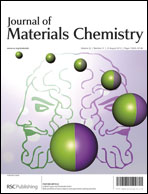A facile and efficient strategy for the preparation of stable CaMoO4 spherulites using ammonium molybdate as a molybdenum source and their excitation induced tunable luminescent properties for optical applications†
Abstract
Stable CaMoO4 spherulites were synthesized by a facile hydrothermal method using (NH4)6Mo7O24·4H2O as a Mo source and these spherulites were formed according to the theoretical predictions of the crystal splitting theory. Rietveld refinement and photoluminescence studies confirmed that the CaMoO4 spherulites are defect-free. The CaMoO4 spherulites showed greenish-blue emission and the single emitting component of CaMoO4:Eu3+ spherulites led to a novel excitation induced efficient emission property like organic light emitting diodes. Cathodoluminescent properties of the CaMoO4:Eu3+ exhibited individual emissions from MoO42− clusters and Eu3+ ions. The white color emissions were clearly explained using Gaussian fitting curves. The corresponding CIE chromaticity coordinates provided their emission potentiality in the green, red and white regions for optical and biological applications.


 Please wait while we load your content...
Please wait while we load your content...